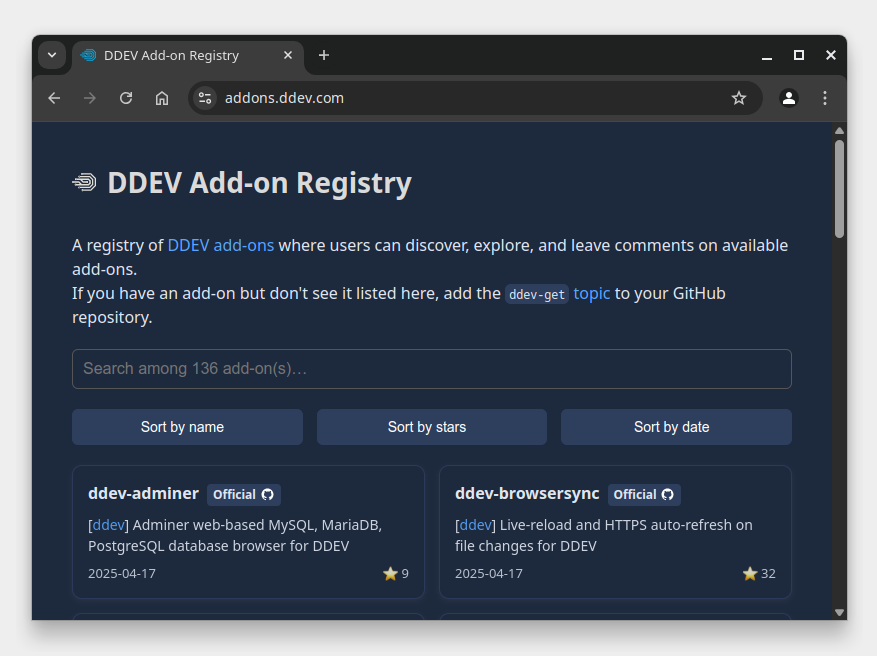DDEV Add-on Maintenance Guide

Introduction
Maintaining a DDEV add-on is more than a one-time task. As DDEV evolves, so should your add-ons. This guide will help you stay in sync with recent changes and keep your add-ons up-to-date, reliable, and aligned with current standards.
As part of preparing this guide, I also updated all official DDEV add-ons to reflect the latest recommendations and improvements.
Recommendations for Add-on Maintainers
Here are some high-level practices to follow:
- Take inspiration from the official add-ons, see how they’re structured and follow similar practices
- Keep an eye on updates in ddev-addon-template
- Track changes in DDEV releases
- Configure your add-on repository settings
- Add the
ddev-gettopic to your GitHub repository if it should be discoverable by the wider community. (If your add-on is currently just an experiment or a fork, wait until it matures to add the topic.) - Write a clear description and include relevant keywords to improve discoverability
- Use
#!/usr/bin/env bashinstead of#!/bin/bashat the top of your command scripts, it’s more portable and works better across different environments. - Ensure your add-on cleans up after itself: both
ddev add-on getandddev add-on removeshould be idempotent. All files added viaproject_filesandglobal_filesmust include a#ddev-generatedstanza to support proper removal - Remember to publish a new release after any update (unless it’s just a
README.mdchange)
I’m currently working on a script to streamline the update process. It’s a work in progress and available here. I’d appreciate any feedback!
What’s New in the DDEV Ecosystem
DDEV development is moving fast, and new features are introduced regularly. Here are some recent updates you should be aware of:
ddev get Deprecation
The classic ddev get command is deprecated in DDEV v1.23.5 and replaced by ddev add-on get.
Huge thanks to @GuySartorelli for implementing this feature, and also for proactively updating many add-on README.md files. You’ve likely already seen a pull request for your add-on!
Better Testing with Bats Libraries
While all add-ons use the Bats framework for testing, many are still missing Bats libraries that simplify assertions and test writing.
Consider adopting these libraries to enhance test clarity and maintainability.
Example:
Issue and PR Templates
Make sure your add-on includes:
These improve the quality of contributions and bug reports.
Recommending DDEV Version Constraints
Your add-on should encourage users to keep DDEV updated. The current recommendation is to add this stanza to install.yaml:
ddev_version_constraint: ">= v1.24.3"This ensures compatibility and resolves known issues, such as those related to the Mutagen Problem Report.
Add-on Badges
The old maintained badge required yearly updates, which became a maintenance burden, especially for contributors with many add-ons. It’s now replaced by a last commit badge.
To improve visibility and engagement on the DDEV Add-on Registry, add the registry badge to your README.md.
Example:
Advanced Customization with Flags
Starting with DDEV v1.23.5, you can now use ddev dotenv set to manage environment variables more cleanly. This allows your add-on to read custom environment variables defined in .ddev/.env.* files, and use them inside your docker-compose.*.yaml configuration.
This feature is especially useful for advanced setups where flexibility and dynamic configuration are needed.
Example:
- https://github.com/ddev/ddev-adminer#advanced-customization
- https://github.com/ddev/ddev-adminer/blob/main/docker-compose.adminer.yaml
Making Small Changes to Docker Images
If your add-on needs a customized Docker image, the typical approach is to create a separate Dockerfile and configure your add-on to use it. However, for minor tweaks, you can take advantage of the dockerfile_inline option in your docker-compose.*.yaml file.
This approach lets you define a small Dockerfile directly in the YAML, avoiding the overhead of maintaining a separate file.
Examples:
- https://github.com/ddev/ddev-solr/blob/main/docker-compose.solr.yaml
- https://github.com/ddev/ddev-opensearch/blob/main/docker-compose.opensearch.yaml
MutagenSync Annotation for Commands
With DDEV v1.24.4, custom commands can now use the MutagenSync annotation.
You should use this annotation if your host or web commands modify, add, or remove files in the project directory. It ensures that file sync is handled correctly when Mutagen is enabled, preventing unexpected behavior or sync delays. (It does no harm and causes no performance issues if Mutagen is not in use.)
Example:
Support for Optional Compose Profiles
The same DDEV v1.24.4 release introduced support for optional docker-compose profiles, which can be used by add-ons to offer more flexible configuration.
Example:
- https://github.com/ddev/ddev-mongo/blob/main/docker-compose.mongo.yaml
- https://github.com/ddev/ddev-mongo/blob/main/commands/host/mongo-express
Repository Configuration Best Practices
To keep your add-on repository tidy, safe, and aligned with community standards, consider adjusting the following GitHub settings:
General Settings
Go to Settings → General in your repository:
- Uncheck features you don’t use, such as Wikis, Discussions, and Projects
- Enable Allow squash merging with Pull request title
- Disable Allow merge commits and Allow rebase merging
- Enable Always suggest updating pull request branches
- Enable Automatically delete head branches
Branch Protection Rules
Go to Settings → Rules → Rulesets:
- Click New ruleset → New branch ruleset
- Set Ruleset name to
main - Under Enforcement status, select Active
- Under Targets, click Add target → choose Include default branch
- Under Rules, enable:
- Restrict deletions
- Require a pull request before merging (set Allowed merge methods to only Squash)
- Block force pushes
- Click Create to apply the ruleset
Conclusion
Keeping your add-on current means less work for users and fewer issues for you to manage. Use this guide as your checklist and stay in sync with the DDEV ecosystem.
Have questions, suggestions, or something cool to share? Join the conversation in our Discord, open an issue, or reach out via email. Your feedback helps improve the tools we all rely on.
If DDEV is helping you or your organization, please consider supporting its ongoing financial sustainability. Every bit helps keep the ecosystem growing and maintained.
Happy maintaining!